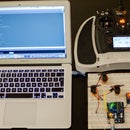Introduction: Arduino and Python Serial Communication - Keypad Display
This Project is made for mac users but it can also be implemented for Linux and Windows, the only step that should be different is the installation.
Step 1: Software Installation
- Download and Install Arduino -> https://www.arduino.cc/en/Main/Software
- Download and Install Python 2.7 -> https://www.python.org/downloads/
- Download Python library "pyserial-2.7.tar.gz" -> https://pypi.python.org/pypi/pyserial
- Unzip pyserial-2.7.tar.gz
- Open Terminal and type:
cd /users/"Your-User-Account"/Downloads/pyserial-2.7
sudo python setup.py install
Software installation ready!
Step 2: Wiring
- Arduino Uno
- Sparkfun 12 Button keypad
The wiring is done without external resistors, instead I used the internal Pullup-Resistors of the microcontroller (internal Pullup-Resistors of Arduino have a value of 20K-Ohm to 50K-Ohm)
To activate the internal Pullup-Resistors set the INPUT-Pins HIGH in the code
If you use another Keypad look at the data sheet for the right wiring, otherwise it could damage your microcontroller
Step 3: Arduino Code
- First we define a chars-Matrix for the Keys
- The keypad uses normal switch connectors that are arranged in 4 rows (Pins 7,2,3 and 5) and 3 columns (Pins 6,8 and 4), are defined as Arrays rowPins and colPins
- The setup() function
- Open the serial gate with Serial.begin();
- Set columns as OUTPUT-Pins HIGH
- Activate the Pullup-Resistors, to do this set rows as INPUT-Pins HIGH;
- The getkey() function
- Set every row LOW and test if one of the columns are LOW. Because of the Pullup-Resistors are all rows HIGH until one key is pushed down. The pushed key generate a LOW-Signal at the INPUT-Pin. This LOW indicates the pushed key in this row and column
- Wait until the key is released and returns the char of the keymap-Array or 0 if no key was pushed
- Use a delay(debounceTime) to stabilise the signal
Attachments
Step 4: Python_2.7 Code
- Import the Serial Library
- Define a variable connected=FALSE, later is this variable used to test if the serial connection is available or not
- Open the Serial Port with serial.Serial("Name of your Serial Port", baud)
- To get the name of your serial port click -> Tools/Serial Port in the Arduino IDLE
- the baud should be the same as in the Arduino Code
- In a while loop test if the connection is available or not reading the serial signal and setting the variable connected=TRUE, it loops until it gets serial connection
- After the connection read the serial in a while loop and put this input in a new variable "var"
- close the port with ser.close()
Attachments

Participated in the
Arduino All The Things! Contest














